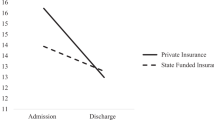Abstract
This study addresses the dearth of research on families of children with serious emotional disturbances (SEDs) by examining parents’ perceptions of their families’ resources and stressors. Parent and/or guardian responses on the Family Inventory of Resources and Stressors (FIRST) whose children were receiving treatment for SEDs (n = 80) were compared to those with children without SEDs (n = 48). One-way ANCOVA analyses revealed that, when controlling for income and education level, families of children with SEDs reported significantly greater stress levels than families of children without SEDs, but both groups reported similar levels of resources. The principles derived from this study provide critical information for treatment providers and researchers seeking to develop an in-depth understanding of the resources and stressors of families of children with SEDs so as to more effectively collaborate with them in treatment planning.
Similar content being viewed by others
References
Anderson, J. A., & Mohr, W. K. (2003). A developmental ecological perspective in systems of care for children with emotional disturbances and their families. Education & Treatment of Children, 26, 52–74.
Beresford, B. A. (1994). Resources and strategies: How parents cope with the care of a disabled child. Journal of Child Psychology and Psychiatry and Allied Disciplines, 35, 171–209. doi:10.1111/j.1469-7610.1994.tb01136.x.
Brannan, A. M., Heflinger, C. A., & Foster, E. M. (2003). The role of caregiver strain and other family variables in determining children’s use of mental health services. Journal of Emotional and Behavioral Disorders, 11, 78–92. doi:10.1177/106342660301100202.
Brinkmeyer, M., Eyeberg, S. M., Nguyen, M. L., & Adams, R. W. (2004). Family engagement, consumer satisfaction, and treatment outcome in the new era of child and adolescent inpatient psychiatric care. Clinical Child Psychology and Psychiatry, 9, 553–566. doi:10.1177/1359104504046159.
Crawford, A. M., & Manassis, K. (2001). Familial predictors of treatment outcome in childhood anxiety disorders. Journal of the American Academy of Child and Adolescent Psychiatry, 40, 1182–1189. doi:10.1097/00004583-200110000-00012.
Cronbach, L. J. (1951). Coefficient alpha and the internal structure of tests. Psychometrika, 16, 297–334. doi:10.1007/BF02310555.
Green, J., Kroll, L., Imrie, M. A., Frances, F. M., Begum, K., Harrison, L., et al. (2001). Health gain and outcome predictors during inpatient and related day treatment in child and adolescent psychiatry. Journal of the American Academy of Child and Adolescent Psychiatry, 40, 325–332. doi:10.1097/00004583-200103000-00012.
Grizenko, N. (1997). Outcome of multimodal day treatment for children with severe behavior problems: A five-year follow-up. Journal of the American Academy of Child and Adolescent Psychiatry, 36, 989–996. doi:10.1097/00004583-199707000-00022.
Hansen, M., Litzelman, A., & Salter, B. R. (2002). Serious emotional disturbance: Working with families. In D. T. Marsh & M. A. Fristad (Eds.), Handbook of emotional disturbance in children and adolescents (pp. 375–391). New York: Wiley.
Heller, M. B. (2005). Reliability and validity of the family inventory of resources and stressors: An extension with clinical and non-clinical samples. Dissertations Abstracts International, 66, 9B. (UMI No. 3189310).
Kernan, J. B., Griswold, M. D., & Wagner, C. M. (2003). Seriously emotionally disturbed youth: A needs assessment. Community Mental Health Journal, 39, 475–486. doi:10.1023/B:COMH.0000003009.21130.da.
Lawrence, E. C. (2005). The Family Inventory of Resources and Stressors (FIRST) Manual. Unpublished manuscript, University of Virginia.
Lawrence, E. C. (2006). Guidelines for a family assessment protocol. In: L. Combrinck-Graham (Ed.) Children in a family context, 2e. New York: Guilford. (pp. 51–70).
Marsh, D. T., & Fristad, M. A. (2002). Handbook of serious emotional disturbance in children and adolescents. New York: Wiley.
McCubbin, H., McCubbin, M., McCubbin, A., & Futrell, J. (Eds.). (1998). Resiliency in ethnic minority families: Vol. II African American families. CA: Thousand Oaks
McLoyd, V. C. (1990). Psychological distress, parenting, and socioemotional development. Child Development, 61, 311–346. doi:10.2307/1131096.
Murry, V. B., Bynum, M. S., Brody, G. H., Willert, A., & Stephens, D. (2001). African American single mothers and children in context: A review of studies on risk and resilience. Clinical Child and Family Psychology Review, 4, 133–155. doi:10.1023/A:1011381114782.
Osher, D. M., Quinn, M. M., & Hanley, T. V. (2002). Children and youth with serious emotional disturbance: A national agenda for success. Journal of Child and Family Studies, 11, 1–11. doi:10.1023/A:1014774526006.
Pfeiffer, S. I., & Strzelecki, S. C. (1990). Inpatient psychiatric treatment of children and adolescents: A review of outcome studies. Journal of the American Academy of Child and Adolescent Psychiatry, 34, 425–433.
Satcher, D. (2000). Children and mental health. In Mental health: A report of the surgeon general. Washington, DC: U.S. Public Health Services. (pp. 124–219).
Smith, T. B., Oliver, M. N., & Innocenti, M. S. (2001). Parenting stress in families of children with disabilities. The American Journal of Orthopsychiatry, 71, 257–261. doi:10.1037/0002-9432.71.2.257.
Stroul, B. A., & Friedman, R. M. (1986). A system of care for children and youth with severe emotional disturbances. Washington, DC: Georgetown University Child Development Center.
Vanderwielen, A. (2003). The psychometric characteristics of the Family Inventory of Resources and Stressors. Dissertations Abstracts International, 64(01), 434B. (UMI No. 3079175).
Walsh, F. (1996). The concept of family resilience: Crisis and challenge. Family Process, 35, 261–281. doi:10.1111/j.1545-5300.1996.00261.x.
Walsh, F. (1998). Strengthening family resilience. New York: Guilford.
Walsh, F. (2003). Changing families in a changing world: Reconstructing family normality. In F. Walsh (Ed.), Normal family processes: Growing diversity and complexity (pp. 3–26). New York: Guilford.
Waters, D., & Lawrence, E. (1993). Competence, courage, and change: An approach to family therapy. New York: Norton.
Acknowledgements
The authors would like to thank Rod DiMotta and the staff at The Astor Home for Children for their assistance in collecting data and their longstanding commitment to serving children with SEDs and their families.
Author information
Authors and Affiliations
Corresponding author
Rights and permissions
About this article
Cite this article
Corliss, B.A., Lawrence, E.C. & Nelson, M.A. Families of Children with Serious Emotional Disturbances: Parent Perceptions of Family Resources and Stressors. Child Adolesc Soc Work J 25, 271–285 (2008). https://doi.org/10.1007/s10560-008-0126-0
Received:
Accepted:
Published:
Issue Date:
DOI: https://doi.org/10.1007/s10560-008-0126-0




